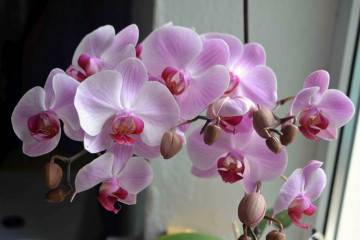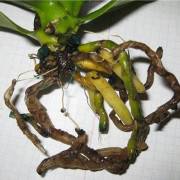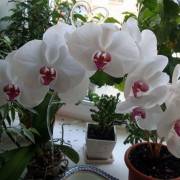How to reanimate an Orchid if it dies
Content:
When growing an orchid, sometimes you have to deal with the problem of flower wilting. It is difficult for inexperienced flower growers to do without special skills and knowledge. To save an exotic flower from wilting, you need to heed the advice of experienced florists.
Causes of wilting orchids
There are many reasons why an orchid withers. With the appearance of new petals, the leaves change. In some cases, most may fall off. This is a natural process that cannot be avoided.
The northern orchid changes foliage every year. It can dry out completely and rot. In spring, the flower blooms again, green fresh foliage appears, which pleases the eye.
An orchid that grows in regions with a tropical climate usually does not change foliage. This type of flower is called two-row and articulated. Its fast and stable growth is ensured by maintaining the balance of moisture and nutrients that the plant receives from favorable climatic conditions. An important role is played by the structure of the leaf plate, which is a kind of reservoir for a decorative flower.
Phalaenopsis is the most popular plant species. His lower leaves mostly fade. 2-3 new ones appear during the year.
The sympodilia orchid has a lot of foliage. Thanks to the root system, new shoots appear, which leads to the formation of a stem and new petals. After this, the pseudobulb grows. Once the process is successfully completed, the orchid begins to dry out.
Lack or excess of moisture
Water for the orchid plays an important role. To accelerate the growth of a flower, you will need to select the appropriate watering regime for the flower. After completing the steps, you need to let the substrate dry. Some plants require daily watering. For others, 1-2 waterings per week are enough. It all depends on the type and structure of the flower.
In summer, the flower needs a lot of water, as the soil dries quickly. If necessary, install additional humidification trays. During this period, spraying of the plant is also required. This procedure is recommended to be carried out every third day.
Damaged roots are no longer able to provide moisture and nutrients to the plant. Therefore, the leaves begin to rot and turn yellow. The ornamental plant needs to be watered regularly. Thus, you can stop the process of wilting of the leaves.
If the roots begin to dry out, then this phenomenon is considered as a lack of moisture or waterlogging. It is advisable to keep the decorative flower under water for 20-30 minutes.
Incorrect temperature conditions
When direct sunlight hits the roots, the plant begins to wilt. Experts do not recommend placing the pot next to the heater. Hot air can kill the flower. Such a type of plant as phalaenopsis, dendrobium is able to withstand temperatures from +16 to 30 ° C.Orchids called Miltonia or Odontoglossum love to grow in cool conditions. The room temperature should not exceed +23 ° C.
Incorrect feeding
Orchids are too sensitive to feeding. Many people believe that the more fertilizer, the faster the growth of a wonderful flower. However, this reasoning is incorrect.
There are feeds with different concentrations of minerals. If you use highly concentrated fertilizers, then you can damage the roots of the plant. Accordingly, they will begin to disappear and die over time. There is also the possibility of getting burned.
During feeding, there is a high probability of root damage. With just one cut, the plant can die. The orchid will rot and stop blooming. Rot can spread to other roots over time. And then the problem of how to properly reanimate the orchid, if the roots have rotted, becomes almost insoluble.
Soil composition and pests
The substrate is the main material for growing a home orchid. The components are:
- moss;
- fern;
- charcoal;
- pieces of foam;
- peat;
- perlite;
- bark of pine trees;
- vermiculite.
Orchid resuscitation is carried out using a quality product. In each specialized store, you can select the appropriate composition that is suitable for a particular type of plant.
When choosing a substrate, you need to pay attention to the following indicators:
- The substrate should be equipped with useful components so as not to retain moisture.
- The correct container must be selected. Moisture should not linger in the middle. This pot should be replaced with a new one immediately.
Diseases
How to notice the first signs of the disease:
- If the plant grows in a transparent container, then you will notice a small bloom that emerges from the algae.
- The leaves begin to wither, become softer and more brittle, due to insufficient moisture and nutrients from the roots.
- Indoor orchids begin to wobble in the pot, as rotten roots are no longer able to create optimal density and keep the plant in a limited volume.
- Roots that take moisture from the air can wither or rot and change color.
The cause of decay can be the onset of a disease. The most common disease is fungal infection.
Many people often wonder how to reanimate an orchid to fight the disease? In order for the roots to stop rotting, you need to purchase chemicals that are sold in specialized stores. A great folk alternative is succinic acid. The product stimulates the growth of leaves and the formation of new roots.
The main ways to save an orchid
How to save an orchid is the most common question that worries many gardeners. There are several ways to properly rehabilitate a plant.
First, you need to conduct a thorough diagnosis and assess the condition of the decorative flower. To determine important reasons, you need to pay attention to the following factors:
- Substrate condition. If moisture is retained or the product has completely dried out along with the roots, then appropriate measures must be taken.
- The appearance of pests - insects.
- The general condition of the flower.
For the purpose of prevention, experts recommend regularly wiping the leaves, removing pests. The pot with the plant should be placed in an aqueous solution for 15-20 minutes.It is recommended to spill the roots with running water.
In addition, you need to pay attention to the temperature regime in the room. The direct rays of the sun should not hit the leaves. If the plant is large, it must be transplanted into another container. It is advisable to regularly process the roots, and then dry them.
Caring for an orchid is challenging. To understand how to properly save a plant, you need to familiarize yourself with the transplant technology. The flower must be removed from the container as carefully as possible so as not to damage the roots with leaves. Next, you need to carefully assess their condition. Then rinse the roots. It is advisable to use running water.
Rotten or dry root must be removed. Processing is carried out using activated carbon powder. For 10 days, the orchid should hold out without a substrate. Orchid resuscitation takes place using a fungicide.
After 10 days, the flower can be placed in a new pot with good quality substrate. Watering adjustments will also be required. After completing the actions, it remains only to wait for the result.
Orchid care after "revitalization"
The question of how to save an orchid without roots and with sluggish leaves is also difficult. If the flower is left without roots, do not throw it away immediately. An ornamental plant can survive with proper care.
There are several ways to save a flower:
- in a home greenhouse;
- without a greenhouse, using regular watering and drying;
- by planting in a regular substrate.
In the presence of living roots, transplanting into a fresh substrate is indispensable. Before resuscitating an orchid, you need to assess its condition. If new roots begin to emerge within a month, the root system can recover up to a year. However, during this time, you will have to provide thorough care.
How to save an orchid without roots depends on a number of factors:
- the general condition of the decorative flower;
- the number of new leaves appearing.
Of no small importance are the conditions that need to be created in order to keep the plant without roots.
How to revive an orchid in a greenhouse environment? In the presence of a window greenhouse, high humidity can be provided. You also need to pay attention to the room temperature. Under good conditions, the weakest flower without a root system can be saved.
To care for the plant, the following steps are performed:
- Take a thin layer of expanded clay, which is placed in a container.
- A layer of cleaned, thoroughly steamed sphagnum is laid on top of it.
- The leaf rosette is placed in a moist substrate until new roots appear.
Until the plant has 3–5 cm long roots, the flower will have to be constantly under cover:
- at air temperatures from 22 to 28 ° C;
- with air humidity within 70-80%;
- in bright diffused lighting for 12-14 hours a day.
When resuscitation no longer makes sense
When all the roots are already rotten and no longer grow, the orchid begins to die. In this case, it is impossible to restore the plant, even using chemicals and providing the most comfortable conditions. The sooner the first signs of a problem are found, the sooner the plants can be saved from death.
With proper care, an exotic plant can be admired. To do this, you will have to closely monitor its condition and regularly monitor the growth of roots and leaves. At the slightest change, you need to use the advice of experienced florists.




















